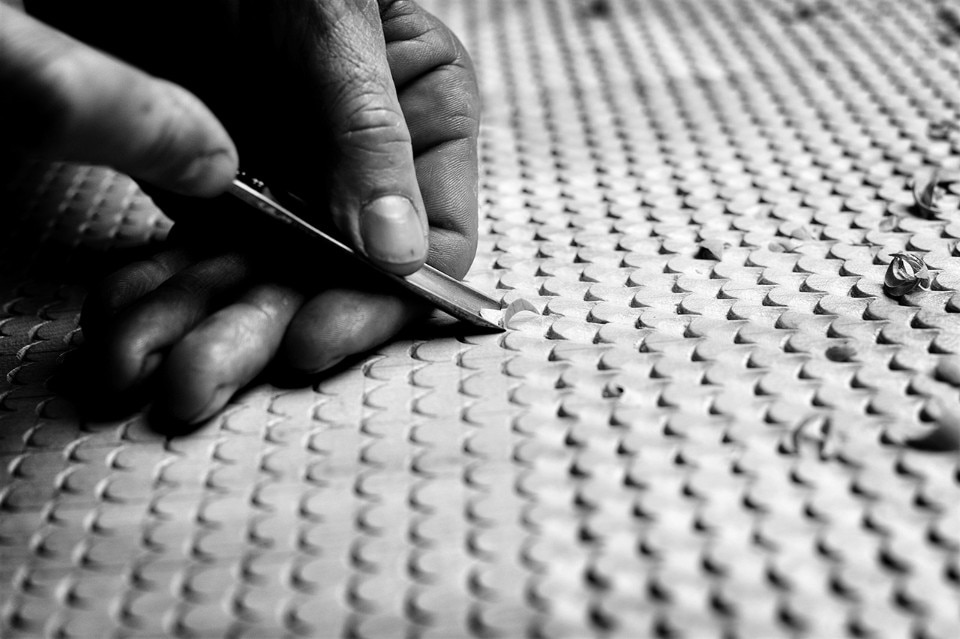Toyota’s first appearance at Milan Design Week had the company pulling up to 31 via Tortona with an exquisite car made of various shades of wood.
Its Setsuna concept car, fully functional but not legally road-friendly, had Japanese cedar for the exterior panels, selected for its flexibility and distinctive grain, and Japanese birch for the frame. The seats showed off Japanese zelkova and smooth-textured castor aralia.
Not on the road alone, other design professionals working with wood offer insight on the qualities behind various wood typologies and technologies.
The Daily Must & The Rare
“The workshop is my favorite place to be,” designer and woodworker Sean Sutcliffe, co-founder of Benchmark furniture, told ArchiExpo e-Magazine in a phone interview. “It’s not about fashion, it’s not about trends, it’s about making furniture that will last for generations.”
The craftsmen at Benchmark stock wood in two ways. First, they bring in a variety of typologies they use most often, depending on location. They have a high preference for Scotland-sourced elm sawn at U.K.-based Tyler Hardwoods. “Not many others work with elm, but we do. It’s a wood with amazing character.”
“Ash is sourced mainly in the U.K., and again comes through Tyler Hardwoods, who are the best ash suppliers in my view. I would like to promote the use of ash because 20 years from now, there may be none left. Two major diseases are on the verge of destroying all of the ash in England.”
Croatian forests, according to Sutcliffe, offer the best oak and Benchmark will often get theirs sawn by Italy-based Florian Group. While they might source their character oak from Tyler Hardwoods, they also work with Vastern Timber. Beyond Europe, they order American walnut from Horizon which “uses a through and through technique to saw their logs, giving them a more European look.”
“Second, we stock what’s rare, precious and beautiful. A few years back, we got 30 logs of Bog oak. It only comes around once in a lifetime. Bog oak is entirely immersed under mud for thousands of years which turns it nearly black.”
The bog or swamp creates low oxygen conditions that protect the oak from normal decay and acidic conditions where iron salts and other minerals react with the tannins in the wood, transforming its color to a distinct brown or almost black.
London-based Studioilse commissioned Benchmark to work on producing the tables for the first-class lounge for Cathay Pacific at Hong Kong’s international airport. “They wanted to inject the furniture pieces with more soul and organic forms,” Sutcliffe said. It took them half a year to find the right timber for the job. Benchmark went to Nelson Butler who supplied enough logs for them to do the tables. “It’s very large, wild European Walnut, left with all the raw edges and holes.”
Kerfing with Skrivo
“All of our projects start from a material or technology,” Stefan Krivokapic, creative director at Skrivo design studio, told ArchiExpo. “We rarely design a product and then try to think about what the best material would be.”
For the series of pendant lamps called Gear—launched at Salone del Mobile in 2015 by the Italian brand Miniforms—“I wanted to find a way of bending wood without using molds. We found one called Kerfing. This requires the cutting of long parallel slats three-quarters of the way into the wood, allowing flexibility so the wood can be bent.”
“This process made it possible for us to design these large wooden pendant lamps using very little wood and without using any molds.”
The lamps are made using Valchromat engineered colored wood. Valchromat colors individual wood fibers with organic dyes and bonds them together with a special resin to create its wood fiber panels.
The design studio keeps an open mind when selecting typologies, depending on the project at hand. Whether using solid wood, bent plywood or steam-bent wood, there are distinct advantages and disadvantages, ranging from function to cost.
Tapping into the Interrupted
In 2015, the Netherlands Studio Thomas Vailly completed their Reconfiguration of a Tree project focused on a bio-based material. The studio decided to work with pinus pinaster, a resinous tree harvested for its pitch.
“The forest of the region Landes in France was the home of a fine wood and pine pitch-based industry and craft. Pine pitch has been used for centuries to waterproof fabric or boats, for example,” Carla Enchelmaier, project assistant at Studio Thomas Vailly told ArchiExpo e-Magazine.
“Still used today, the raw material now comes from non-E.U. countries and the pitch is highly processed. Due to the alternative synthetic material, the tapping of pine pitch has been interrupted in France and this technique is now disappearing.”
Studio Thomas Vailly ripped apart the Pinus Pinaster tree and rearranged its elements into a man-made material, resulting in a black natural resin used for joining, coating and blending.
After developing the new material, Studio Thomas Vailly had four designers apply it to a product: David Derksen, Gardar Eyjolfsson, Lex Pott and an in-house designer from Studio Thomas Vailly.

















